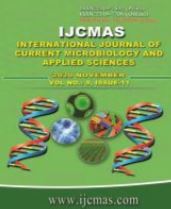


 National Academy of Agricultural Sciences (NAAS)
National Academy of Agricultural Sciences (NAAS)

|
PRINT ISSN : 2319-7692
Online ISSN : 2319-7706 Issues : 12 per year Publisher : Excellent Publishers Email : editorijcmas@gmail.com / submit@ijcmas.com Editor-in-chief: Dr.M.Prakash Index Copernicus ICV 2018: 95.39 NAAS RATING 2020: 5.38 |
Maize is considered to be the third most important cereal after rice and wheat in India. It is being cultivated worldwide in a wider range of environmental conditions, because of its greater adaptability. It is known to be affected by more than 62 diseases. Among them, turcicum leaf blight caused by Exserohilum turcicum (Pass.) Leonard and Suggs is of significant importance as it drastically reduces the yield by reducing photosynthetic activity of the plant. Effect of secondary metabolites obtained from Trichoderma virens, was utilized in the study to understand and overcome many of the problems associated with the application of chemical pesticides in comparison to commercially available various Trichoderma formulations. In vitro studies have demonstrated that, among the different treatments tested, Trichoderma secondary metabolites (TSM), Neem seed kernel extract, combination of TSM with NSKE at 20 per cent concentration has showed highest per cent inhibition of mycelial growth of 61.28, 72.59 and 68.63 per cent respectively. Among the fungicides tested, maximum inhibition of mycelial growth of E. turcicum (100 %) was observed in both Tebuconazole (25.9 % EC) and Hexaconazole (5 % EC) at all the different concentrations tested.
 |
 |
 |
 |
 |